Measures of San Antonio’s Social Capital—Perceptions of Social Trust
By Darla Norton, Research Associate, Juanita M. Firestone, Ph.D., Professor, and Arturo Vega, Ph.D., Associate Professor
Issue:
Robert Putnam’s Bowling Alone (2000) brought renewed attention to the concept of social capital. Social capital is a measure of the levels of social relationships and social networking within communities and individuals and is typically measured by levels of social trust, networks and reciprocity that connect communities and form social cohesion. The gist of the argument over social capital is that people who are socially, politically and economically integrated equally within elements of a community can work together to solve their problems and create a caring and trusting community. Putnam’s book argued that since the mid-1960s, social capital elements of political trust, social connectedness and civic activity have declined in U.S. society and that continued erosion is detrimental to our democratic society and it’s functioning.
This issue brief is the first of a series of analyses that examine social capital in Bexar County (San Antonio), Texas. This brief examines the element of social trust at the community level. The research questions are: What are the levels of social trust in San Antonio, Texas? Are there significant variations in levels of social trust among key demographic groups that make up the community?
Data and Methods:
Data for this study were collected during the San Antonio Survey 2003 (SAS 2003), which was conducted during the weeks of October 12-28th, 2003.[i] Responses are from a random probability sample of the general population of adults 18 years of age and older in Bexar County, (San Antonio) Texas, with listed phone numbers. A split sample design produced 423 responses from a random sample of individuals within the county, and an additional oversample of 136 respondents living on San Antonio’s West Side for a total of 559 respondents.[ii] To measure levels of social trust, two questions were asked: “Generally speaking would you say that most people can be trusted or that you can’t be too careful in dealing with people?” (GENERAL TRUST) and “How much do you trust the people in your neighborhood?” (TRUST NEIGHBORS).
Findings:
In response to whether “most people can be trusted” over four in ten (42.1%) of SAS respondents reported that you “can’t be too careful when dealing with people,” while over one third (36.1%) felt “people can be trusted” and more than one in five (21%) of respondents said “it depends” (see Figure 1).
When asked how much they trusted people in their neighborhood, forty-two (42) percent of respondents reported trusting people in their neighborhood ‘a lot,’ one-third (33%) indicated ‘some trust,’ and seventeen (16.6) percent reported ‘only a little trust.’ Eight (8.4) percent of the respondents revealed that they did not trust their neighbors “at all” (see Figure 2).
Table 1 presents distributions on ‘GENERAL TRUST’ and ‘TRUST NEIGHBORS’ questions by demographic groupings. Consistent with other studies these results indicate that ‘GENERAL TRUST’ and ‘TRUST NEIGHBORS’ are significantly (p < .01) associated with age, such that young adults reported less trust and seniors reported more trust. In addition, respondents are much less trusting of others in general than they are of their neighbors for each of the age categories. For example, almost twenty-two (21.8%) percent of the respondents between the ages of 18 and 29 believe that people can be trusted, while only ten (10.5%) percent of respondents in the same age group said they trusted their neighbors.
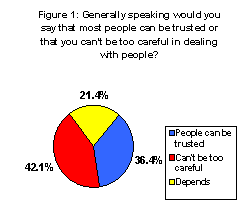 |
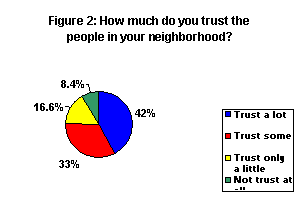 |
Levels of social trust are significantly (p < .01) associated with income level with trust increasing among those with higher incomes. Respondents with lower incomes were significantly less trusting of others and their neighbors compared with respondents of higher incomes. Only about one in five respondents in the lowest income group indicated a general level of trust or trust in the neighbors compared to over half of the respondents in the highest income grouping. Income is moderately (Cramer’s V = .27; Gamma = .44) associated with ‘GENERAL TRUST’ and substantially (Cramer’s V = .33; Gamma = .52) associated with ‘TRUST NEIGHBORS’.
Race/ethnicity was weakly associated (Cramer’s V = .18) with ‘GENERAL TRUST’ and moderately associated (Cramer’s V = .31) with ‘TRUST NEIGHBORS, but both were significant (p < .01). Anglo respondents were almost twice as trusting in general (44.9%) compared to Hispanics (27.7%) and African Americans (27.8%). The relationship was stronger for trust of neighbors where over half of Anglos (56.2%) said they trusted their neighbors compared to only two in ten (20%) of African Americans and to one in four Hispanics (26.8%).
Educational attainment was moderately associated with ‘GENERAL TRUST’ (Cramer’s V = .28; Gamma = .40) and ‘TRUST NEIGHBORS’ (Cramer’s V = .31 Gamma = .44) with both relationships were unlikely due to chance (p < .01). Respondents without a high school diploma were the least trusting, with only about two in ten reporting that they generally trusted others or trusted their neighbors, compared to half of the respondents with bachelor’s degrees.
There were no significant differences in levels of social trust between males and females. These negligible or weak relationships had a Gamma of -.03 for ‘GENERAL TRUST’ and .11 for ‘TRUST NEIGHBOR’ and were not statistically significant at the .05 level.
In addition, living inside or outside Loop 410 made no difference as to whether respondents trust other people or trust their neighbors. Both relationships were negligible with a gamma of .12 for ‘GENERAL TRUST’ and .05 for ‘TRUST NEIGHBOR’ and were not statistically significant at the .05 level. On the other hand, living on the West Side was moderately and significantly associated with ‘GENERAL TRUST’ and substantially associated with ‘TRUST NEIGHBORS.’ Respondents not living on the West Side were twice as trusting of other people (40.9% vs. 21.4%) and their neighbors (48.5% vs. 18.4%) compared to respondents living on the West Side.
TABLE 1: SOCIAL TRUST BY DEMOGRAPHIC DETERMINANTS
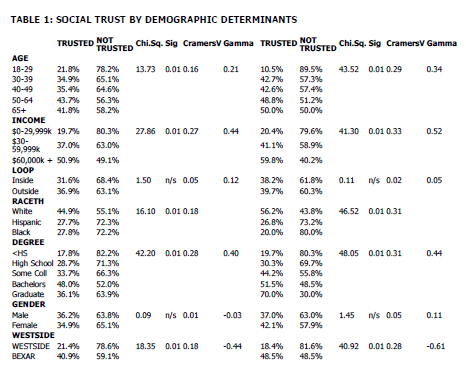 Click on graphic to view PDF version of table. |
GENERAL TRUST TRUST NEIGHBOR
Finally, Figures 3 and 4 display the two dimensions of trust (GENERAL TRUST and TRUST NEIGHBORS) by those respondents race/ethnicity, controlling for geographic location. These figures demonstrate that when race/ethnicity is controlled by location: 1) Westsiders (WS) have lower levels trust compared to others in Bexar County; 2) Hispanics not living on the West side are more trusting of others or their neighbors compared to Hispanics from the West Side (GENERAL TRUST: 32.8% vs. 21.3%)
(TRUST NEIGHBORS: 34.9% vs. 16%); and 3) Anglos not living in the West side are also more trusting compared to their counterparts who reside in the West side (GENERAL TRUST: 46.4% vs. 18.2%) (TRUST NEIGHBORS: 57.9% vs. 25%).
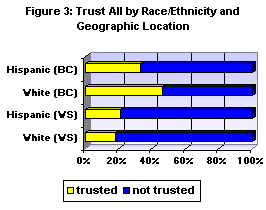 |
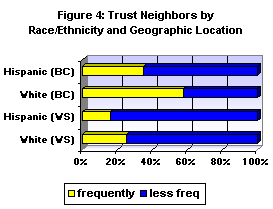 |
Discussion:
Communities that are characterized by racial, ethnic, religious, or political diversity typically demonstrate lower levels of social trust. These survey findings suggest that levels of social trust in San Antonio are significantly related to age, income, race/ethnicity, educational attainment and living on the “west side.” Residents on the West Side, racial and ethnic minorities, young adults, the poor, and the least educated exhibit the least amount of social trust. Our results indicate that most individuals are more trusting of neighbors than people in general. These results reinforce the idea that individuals tend to view people similar to themselves (neighbors) in a more positive light than those with whom they have little contact or have limited knowledge about (and consequently less trustworthy.) If social trust is essential to a developing a community that works together, then these findings underscores the importance of educating the community about the benefits of diversity. Understanding and accepting all members of the community, not just those we believe are similar to us, is the key to establishing social connectedness and working together to solve social problems.
REFERENCE
Putman, Robert D. (2000) Bowling Alone—The Collapse and Revival of American Community. New York: Simon and Schuster.
Notes
[i] The SAS 2003 is an annual survey conducted by UTSA students in research methods courses in sociology, criminal justice, kinesiology and public administration, in conjunction with The Culture and Policy Institute. The survey provides students with experience in survey research and an opportunity to measure the attitudes and perceptions of San Antonians on topics of the day. Juanita Firestone, Professor, Department of Sociology, is the principal investigator; Richard Harris, Professor, Department of Sociology, and Arturo Vega, Associate Professor, Department of Public Administration, are co-principal investigators.
[ii] The standard error for the entire sample, including the additional sample from the Westside, is +/- 4.1% with a confidence level of 95%. The SAS 2003 incorporated several questions from the Saguaro Seminar’s “Social Capital Community Benchmark Survey Short Form 2001.” The authors acknowledge the Seminar for its generosity in sharing the short form on line. www.ksg.harvard.edu/saguaro/pdfs/socialcapitalshortform.pdf